The Royal Family's links with Newmarket date back to at least the early part of the 17th century when James I enjoyed his visits to the town to pursue his hobbies of hawking and hunting. In the period between 1606 and 1610 a Palace was built for James I on land closer to All Saints' Church than the current Palace House. By 1619 the Prince, later Charles I, had lodgings built on Newmarket High Street, close to the present day Kingston House, and continued his association with the town after his father's death on 25th March 1625. As Charles I he enjoyed his frequent visits to Newmarket, often accompanied by his son, later Charles II. Indeed, during the Civil War it is said that Charles I was holed up at his Palace in Newmarket for almost two weeks in 1647. Charles I was executed on 30th January 1649, after which little interest was shown in the Royal Palace at Newmarket and it was left to deteriorate until it was gradually demolished. By 1660 the old palace was run down and in need of urgent restoration. The Surveyor of the Royal Stables, John Baypole, was awarded £800 (equivalent today to £170,000) to restore and repair the old palace. However, by 1666 Charles II rekindled his interest in horse racing, and in particular his desire to return to Newmarket which he had enjoyed in his youth. During his visits he made use of Thomond House in Newmarket, and nearby Audley End House as a guest of the 3rd Earl of Suffolk, spending increasing amounts of time in the town. By 1669 he was staying 3 weeks annually, which increased to 5 weeks the next year, and by 1682 he was visiting for the best part of 7 weeks. One of the many Newmarket courses shown on the map below, the Round Course of 3 miles 6 furlongs and 93 yards, was set up in this period and, within two years, Charles II had directed architect William Samuel (Samwell in some newspapers) to design him a sporting Palace 'fit for a King', a project which began in 1668 and was completed by 1671. The Newmarket Town Plate, still run to this day, was introduced around this time and was won by Charles II on Saturday 14th October 1671, and again on Saturday 14th October 1675. Charles II enjoyed his frequent visits to his Royal Palace, riding out at least twice a day on his favourite horse 'Old Rowley' and Nell Gwynn, whose house can still be seen today a short walk from Palace House. Charles II died on 6th February 1685 and was followed, for a short period, by James II, and then in 1689 by William III and Mary. William III enjoyed his horse racing and made frequent visits to his Royal Palace in Newmarket right up to the time of his death on 8th March 1702. The Royal stables were well stocked and overseen by the 'Keeper of the Running Horses' which, in William IIIs time was Tregonwell Frampton. William was succeeded by Queen Anne who visited Newmarket regularly and upgraded the Royal Palace during her reign. She was also instrumental in establishing Ascot racecourse. She died on 1st August 1714 sending the whole country into a prolonged period of mourning, and was succeeded by George I who was not particularly keen on racing and is reported to have only ever visited Newmarket and his Royal Palace on one occasion in October 1717. He is reported to have granted a lease of Palace House and its land to Charles Seymour. George I was succeeded by George II on 11th June 1727, who reigned until his death on 25th October 1760, although for the majority of this period Palace House was leased to the Seymour's.
July 1721-1748 Charles Seymour, 6th Duke of Somerset
Charles Seymour, 6th Duke of Somerset, was born on 13th August 1662 and educated at Harrow School and Trinity College, Cambridge. He became known as 'The Proud Duke' and rebuilt Petworth House in Sussex. In July 1721 he obtained a 31-year lease from George I of the land on which the former Old King's Palace stood, paying annual rent of £30 to the housekeeper of Palace House. He died on 2nd December 1748, but the lease passed to his daughter Lady Frances Seymour.
2nd October 1724 WINDHAM owned by the Duke of Somerset, beat CRICKET, owned by the Duke of Devonshire, over 4 miles at Newmarket
26th October 1730 GREY-LEGS, owned by the Duke of Somerset, beat POLLY owned by the Duke of Devonshire, in a Newmarket Sweepstake
7th April 1739 His Majesty's 100 Guineas Plate CHIDDY owned by the Duke of Somerset
December 1748-January 1761 Lady Frances Seymour, John Manners, Marquess of Granby
On the death of her father in December 1748 Lady Frances Seymour took over the lease of the old King's Palace to the west of Palace III. On 3rd September 1750 she married John Manners, the Marquess of Granby, eldest son of the Duke of Rutland, who later became the 9th Duke of Rutland. By the time of his marriage he had already acquired two illegitimate children, but he and Lady Frances produced a further 6 children. She died on 25th January 1761.
For over 4 centuries racing has been staged in Newmarket, but how have the racecourses evolved from an initial starting point at Fleam Dyke Pumping Station, some 8 miles from the town, with a winning post barely 200 metres from the town centre, into two world recognized, excellent racecourses and a universal acceptance that Newmarket is the Headquarters of racing?
To access an interactive racecourse map showing over 50 individually named racecourses CLICK HERE. The map will enable you to:-
1. Determine when extended races over 8 miles, 6 miles and 4 miles began to be replaced by the courses now visited by thousands annually;
2. Consider how the challenge of crossing the Devil's Dyke was overcome;
3. Contemplate why the town no longer has a steeplechase course despite having at least 5 courses during the past 2 centuries;
4. Examine the practicalities of having up to 48 starting posts and winning posts;
5. Appreciate that it was not financially viable to have an open racecourse spread widely across the heath, with a finishing post barely 200 metres from the town centre;
6. Research how and why the Cambridgeshire Handicap has been contested over 3 different courses.
NOTE: The map does not make mention of 2 particular courses:-
(i) Sefton Course (also known as the Cambridge Road Course)
Source: 1970 Raceform. Used from 1959 to 1975.
(ii) New Circular Course
The Circular Handicap was run on Friday 29th October 1875 on the New Circular Course of about two miles.
Source: London Standard (30th October 1875): ''the horses started near the Turn of the Lands, ran back way of the Cambridgeshire Course towards the Ditch, and afterwards proceeded down the side of the Tan Gallop, and turned into the Rowley Mile near the Bretby Stakes starting post, finishing at the stand at the end of the flat. Except in the hollow near the Cambridgeshire start the runners should have been visible all the way if the sky had been bright and clear''.
Another report hoped that the Circular Handicap would become a feature in future programmes, as it would be contested in front of the new grandstand which would be completed in about a year and would be able to accommodate thousands.
(I am grateful to Tim Cox for bringing attention to these 2 courses.)
Enjoy researching the intriguing history of Newmarket and its many racecourses.
1750-1765 William Augustus, Duke of Cumberland
Prince William Augustus, the Duke of Cumberland, third and youngest son of George II and Caroline of Ansbach, was born on 26th April 1721. He is best remembered for putting down the Jacobite Rising at the Battle of Culloden in 1746. He was passionate about horse racing and, in 1753, became the first member of the Royal Family to become a Jockey Club Member. He visited Newmarket for the racing every year between 1753 and his death in 1765 and oversaw the refurbishment of part of the Palace on which the former Greyhound Inn once stood. In the early part of 1760, the Duke's Stand was built opposite the Old Betting Post. about 2 furlongs from the Beacon Course winning post. He died on 31st October 1765.
5th October 1754 Newmarket 300 Guineas over 4 miles SQUIRT owned by the Duke of Cumberland
24th April 1756 Newmarket 200 Guineas over Beacon Course CRAB owned by the Duke of Cumberland
9th October 1756 Newmarket 200 Guineas over Beacon Course CARISTINA owned by the Duke of Cumberland
7th October 1758 Newmarket 500 Guineas over Beacon Course MORO owned by the Duke of Cumberland
21st April 1759 Newmarket 200 Guineas over 4 miles CATO owned by the Duke of Cumberland
12th April 1760 Newmarket 500 Guineas over 4 miles SPIDER owned by the Duke of Cumberland
17th April 1762 Newmarket 500 Guineas over 4 miles DORRIMOND owned by the Duke of Cumberland
28th April 1763 Newmarket 500 Guineas over 4 miles DUMPLIN owned by the Duke of Cumberland

1760-1808 George III, George IV, Frank Neale, Caswell
George William Frederick, grandson of George II, and eldest son of Frederick, Prince of Wales and Princess Augusta of Saxe-Gotha-Altenberg, was born at Norfolk House, St James's Square, London on 4th June 1738. He succeeded his grandfather on 25th October 1760, and went on to reign for 60 years until his death on 29th January 1820. During this time his son, the Prince Regent, later George IV, pursued his hobby of horse racing and would have been a frequent visitor to the Royal Palace at Newmarket, although his father, George III, did own horses which ran under the name Thomas Panton, master of the King's Running horses. The Prince of Wales certainly made use of the Newmarket trainer Frank Neale, although it is uncertain whether the trainer was based at Palace House Stables except for the period 1780-83. He was a public trainer who was very successful, training the 1788 Epsom Derby winner Sir Thomas (SR 1953) for the Prince of Wales, but also being responsible for a further 10 classic winners, as shown below. In 1785 the Prince of Wales purchased the 1783 Epsom Derby winner Saltram (SR 2032) well after it had triumphed at Epsom. He bought the colt in late 1784, and it raced in his colours at the 1785 Craven Meeting, finishing second to Dungannon before winning a 200 Guineas Sweepstake over the Abingdon Mile, beating Lord Clermont's Cantator. Saltram was then retired to the Prince's private stud. The Prince of Wales was in dispute with a number of Newmarket people on the turf, notably Sam Chifney after the well-publicised Eclipse affair in 1791, and he began to reduce his interest in racing, especially in Newmarket. Indeed, he gave instructions in 1808 that all his thoroughbreds should be sold and his interest in the turf terminated. In the end he decided not to support Newmarket races, but did continue enjoy racing at Bibury, Lewes and Brighton during a period when he was undecided which direction to take. However, it was also during this period that part of the Royal Palace, formerly the Lord Chamberlain's lodgings, was demolished in 1814 and later sold by the Crown in 1819. In 1815 it was clear that the King, George III, was not himself and it relied on the Prince Regent to oversee affairs of state. During the 5-year period before the King died the Prince put his equerry Colonel Leigh in charge of Palace House and its renovation. By 1826 George IVs passion for racing was rekindled and he invited William Edwards to be his private trainer.
1782 Epsom Derby ASSASSIN (SR 2003) 5/1 owned by George Wyndham, 3rd Earl of Egremont, trained by Frank Neale and ridden by Sam Arnull
1783 Epsom Derby SALTRAM (Sr 2032) 5/2 jt fav owned by John Parker, trained by Frank Neale and ridden by Charles Hindley
1786 Epsom Derby NOBLE (SR 1983) 30/1 owned by Tommy Panton, trained by Frank Neale and ridden by John White
1788 Epsom Oaks NIGHTSHADE (SR 2001) 1/2 fav owned by 3rd Earl of Egremont, trained by Frank Neale and ridden by Dennis Fitzpatrick
1788 Epsom Derby SIR THOMAS (SR 1953) 5/6 fav owned by HRH Prince of Wales (later King George IV), trained by Frank Neale and ridden by William South
1789 Epsom Oaks TAG (SR 1951) 5/2 jt fav owned by 3rd Earl of Egremont, trained by Frank Neale and ridden by Sam Chifney
1795 Epsom Oaks PLATINA (SR 1936) 3/1 owned by 3rd Earl of Egremont, trained by Frank Neale and ridden by Dennis Fitzpatrick
1796 St Leger AMBROSIO (SR 2008) 4/5 fav owned by Joseph Cookson, trained by Frank Neale and ridden by John Jackson
1798 Epsom Derby SIR HARRY (SR 1965) 7/4 fav owned by Joseph Cookson, trained by Frank Neale and ridden by Sam Arnull
1800 Epsom Oaks EPHEMERA (SR 1939) 9/4 fav owned by 3rd Earl of Egremont, trained by Frank Neale and ridden by Dennis Fitzpatrick
1804 Epsom Derby HANNIBAL (SR 2046) 3/1 owned by 3rd Earl of Egremont, trained by Frank Neale and ridden by Bill Arnull
1808-1826 James 'Tiny' Edwards
James Edwards, father of jockeys William, Harry, George, Charles, Edward and Frederick from 3 different marriages, trained at Palace House Stables from the early part of the 19th century until 1826. During this time the number of boxes at Palace House Stables increased by an additional 15 in the early 1820s. James transferred to Mickleham, then seen as the equal of Middleham and Newmarket as a training centre, to continue his training career, saddling Mameluke (SR 2030) to win the 1827 Epsom Derby, Bay Middleton (SR 2062) to win the 1836 2000 Guineas and Epsom Derby, Riddlesworth (SR 2035) to win the 1831 2000 Guineas, and 4 consecutive 2000 Guineas winners between 1834 and 1837. On leaving Palace House he handed over the reins to his oldest son William who was invited by King George IV to become his private trainer.
1811 Epsom Derby PHANTOM (SR 2001) 5/1 owned by Sir John Shelley, trained by James Edwards and ridden by Frank Buckle
1819 2000 Guineas ANTAR (SR 1940) 4/1 owned by Sir John Shelley, trained by James Edwards and ridden by Edward Edwards
1824 1000 Guineas COBWEB (SR 2032) 5/2 owned by 5th Earl of Jersey, trained by James Edwards and ridden by Jem Robinson
1824 Epsom Derby CEDRIC (SR 2046) 9/2 owned by Sir John Shelley, trained by James Edwards and ridden by Jem Robinson
1824 Epsom Oaks COBWEB (SR 2032) 8/11 fav owned by 5th Earl of Jersey, trained by James Edwards and ridden by Jem Robinson
1825 Epsom Derby MIDDLETON (SR 2031) 7/4 fav owned by 5th Earl of Jersey, trained by James Edwards and ridden by Jem Robinson

1826-June 1830 George IV, William Edwards
George Augustus Frederick, eldest child of George III and Queen Charlotte, was born at St James's Palace on 12th August 1762. During his time as Prince Regent he pursued his pastime of horse racing, employing Frank Neale and Caswell as his trainers until their death. He succeeded his father on 29th January 1820, reigning until his death on 26th June 1830, to be succeeded by his younger brother William IV. It was during his period in office that the Palace House Stables were extended to add a further 12 boxes.
June 1830-June 1837 William IV, William Edwards
William Henry, third son of George III and Queen Charlotte, was born in the early hours of 21st August 1765 at Buckingham House, and succeeded to the throne on the death of his elder brother George IV on 26th June 1830. He reigned until his death at St George's Chapel, Windsor, on 20th June 1837.
1826-1853 William Edwards, Duke of Rutland, Duke of Bedford
William Edwards, eldest son of successful royal trainer James 'Tiny' Edwards, was born into a racing family and was destined to forge a career in racing. He rode for the Prince of Wales in his youth, but by the time he was 20 he took charge of the Duke of Rutland's Stud at Cheveley Park. However, when the Prince Regent's former trainers, Frank Neale and Caswell, died the Prince invited William to train his horses at Palace House Stables. He was extremely talented and successful, winning a number of Classics and Gold Cups, but arguably the highlight of his career was reached in the 1830 Goodwood Cup when 3 of the King's horses, Fleur de Lis, Zinganee and The Colonel, in a field of 9, occupied the first three places in the order stated, with Fleur de Lis winning when trained by Edwards. Such was the high esteem in which King George IV held William Edwards that, on his death on 26th June 1830, he bequeathed William £300 per annum for life, a bequest which William benefitted from for almost 50 years. William continued to train at Palace House as a public trainer, including some of the horses of King William IV, while the Duke of Rutland with Royal connections became the final resident at Palace House prior to it being sold by The Crown in 1857. William Edwards retired in 1853, having trained as a public trainer for the likes of the Dukes of Bedford and Beaufort, the Earl of Albemarle and Admiral Rous. William left the Palace to live in very comfortable circumstances at Windsor for the next 21 years. Sadly in 1872 apoplexy took his wife, Jane, suddenly, and his mind largely failed as a result. He was found unfit to look after his affairs but continued to live at his home in Trinity Place, Windsor, until his death on 2 September 1875.
1830 Goodwood Cup FLEUR DE LIS 7/2 owned by HM King William IV, trained by William Edwards and ridden by George Nelson, with the King's other horses, The Colonel and Zinganee finishing second and third.
1838 1000 Guineas BARCAROLLE (SR 1862) 4/1 owned by 4th Earl of Albemarle, trained by William Edwards and ridden by Edward Edwards
1841 2000 Guineas RALPH (Sr 1952) 5/2 owned by 4th Earl of Albemarle, trained by William Edwards and ridden by John Barham Day
1843 Ascot Gold Cup RALPH owned by 4th Earl of Albemarle, trained by William Edwards and ridden by Jem Robinson
1844 Ascot Gold Cup THE EMPEROR owned by 4th Earl of Albemarle, trained by William Edwards and ridden by George Whitehouse
1845 Ascot Gold Cup THE EMPEROR owned by 4th Earl of Albemarle, trained by William Edwards and ridden by George Whitehouse
At the 1840 Royal Ascot meeting Newmarket Stables won about two-thirds of the first-place prize money, out-performing other prominent racing centres. Three different Newmarket Stables provided winners, with William Edwards leading the way with 2 victories.
William Edwards
Coronation Stakes:-SPANGLE (5/2)
Trial Stakes (Queen Anne):-FLAMBEAU (4/7 fav)
Robert Pettit
Gold Cup:-ST FRANCIS (5/2 fav)
Gold Vase (Queen's Vase):-ST FRANCIS (2/1)
Charles Marson
Wokingham Stakes:-HELLESPONT (7/1)
St James's Palace Stakes:-SCUTARI (4/6 fav)


1857-1858 Robert George Pettit
In the 1858 Kelly's Directory Robert George Pettit was listed as both the trainer and jockey at Palace House Stables. His father, also called Robert, was born in 1794 and was assistant to James Tiny Edwards. Robert then travelled to India for a short time before returning to Newmarket to embark on his own career as a public trainer. His son was born in 1821 and had a long, but not particularly successful, career as a jockey. He was nicknamed 'The Pieman' and partnered The Widow (30/1) to success in the 1847 Cambridgeshire for owner Mr Leigh. His other big success was in the 1855 Coronation Stakes aboard Alcyone (11/2) for the Duke of Bedford, after which he launched his training career. He was based at Palace House Stables, was certainly resident in 1858, but probably moved on when Baron Mayer de Rothschild appointed Jem Godding in 1858. Robert Pettit senior died in Newmarket on Sunday 8th December 1861 aged 67, whilst Robert Pettit junior died in Newmarket on 29th August 1875 aged 54.
April 1855-1873 Baron Mayer Amschel de Rothschild, Thomas Carter snr, William Butler, James (Jem) Godding
Baron Mayer de Rothschild purchased Palace House Stables from The Crown in April 1855, buying Palace House 2 years later, and set about improving the Stables for the next 4 years, initially installing firstly Thomas Carter senior, then William Butler and then James 'Jem' Godding as his trainer. The first changes he made were to demolish the16 box famous Stables dating from Charles II day, replacing it with a modern Trainer's House and the new King's Yard stable block. Later, in 1863, the Queen Anne Pavilion was demolished, creating the space to build a Congregational Chapel, while in that same year Jem Godding trained Macaroni (SR 2017) to win the 2000 Guineas and Epsom Derby, the first time a Newmarket trainer had trained a Derby winner since 1844, when Orlando (SR 2013) trained by Mr Cooper was victorious. It was such a memorable occasion in Newmarket, having not enjoyed a Derby winner for so long, that a peal of the bells of All Saints Church, Newmarket, were rung for some considerable time. The church, at that time, was at a 90 degree alignment to the present day church. James 'Jem' Kealey Godding was certainly still in place in 1871 as detailed in the census of that year.
1862 Epsom Oaks FEUE DE JOIE (SR 1949) 20/1 owned by Richard Naylor, trained by Jem Godding and ridden by Tom Chaloner
1863 2000 Guineas MACARONI (SR 2017) 10/1 owned by Mr Richard Naylor, trained by Jem Godding and ridden by Tom Chaloner
1863 Epsom Derby MACARONI (SR 2017) 10/1 owned by Mr Richard Naylor, trained by Jem Godding and ridden by Tom Chaloner
1855-1880 Joseph Hayhoe, Baron Mayer Amschel de Rothschild, Hannah Primrose, Sir Anthony Nathan de Rothschild, Leopold de Rothschild
Baron Mayer de Rothschild purchased Palace House Stables in 1855 and set about improving it for the next 4 years, installing James Godding as his trainer. He also employed Joseph Hayhoe, who was with him throughout the period 1855 to 1874, the majority of the time training at Palace House Stables, but he transferred some of his horses to Primrose Cottage, also owned by de Rothschild, between 1861 and 1880, although it is uncertain whether he just used this as an overflow stable for Palace House. Further work was carried out on Palace House in 1867 under the direction of the architect George Devey, in particular adding a dining room and some additional work on the second floor. Joseph Hayhoe was born in a small village near to Norwich, entering the racing stable of James Edwards when he was very young, at a time when Edwards trained the likes of Mameluke, Glencoe and Bay Middleton for Lord Jersey. To gain further experience Joseph ventured further north to the hugely respected stables of John Scott, some of the finest in the land at that time, where Joseph became Head Lad. In 1855 he launched his own training career at Russley, near Hungerford in Berkshire, training for Baron Mayer de Rothschild. In late 1856 he moved to Newmarket, where the Baron had just taken over Palace House Stables. For almost a quarter of a century Joseph was associated with the Rothschilds, firstly with Mayer de Rothschild until his death on 6th February 1874, followed by Anthony de Rothschild until he died on 2nd January 1876, and finally with Leopold de Rothschild. On the death of her father, Mayer de Rothschild, his daughter Hannah de Rothschild inherited his vast fortune, making her the wealthiest woman in Britain. Part of that inheritance was Palace House Stables, although she gave her uncle, Sir Anthony Nathan de Rothschild, authority to run the stables and house on her behalf until his death in January 1876. Two years later, in 1878, she married Archibald Primrose, 5th Earl of Rosebery, who later served as Prime Minister between 5th March 1894 and 22nd June 1895. By then Hannah had passed responsibility for Palace House over to Leopold de Rothschild. Throughout his time at Palace House and Primrose Cottage Joseph Hayhoe experienced tremendous highs, when many of the Rothschild's horses won principal races, but there were also many lows with family deaths and tragedies. On 29th March 1862 his wife, Mary, died aged just 48, although Joseph remarried 3 years later on 5th March 1865. In the 3-year period 1868 to 1871 Joseph experienced 2 weddings and 3 funerals. On 5th March 1868 his son, Joseph jnr, married Lucy Smith, daughter of the Newmarket training groom W. Smith, while on Monday 1st June 1868 his daughter Louisa married jockey James Grimshaw. In August 1868 his 4th son, John, died of typhoid fever at Chantilly, while on 31st July 1869 his son, Edward, died of consumption aged just 21. Joseph's other daughter had married stable jockey John Daley, but she tragically died in December 1871 after a long illness. Despite all of these family tragedies Joseph had enjoyed tremendous success in his long training career. He trained 3 Epsom Derby winners, 1871 Favonius (Sr 2017), 1879 St Bevys (SR 1955) and 1876 Kiber (SR 2061). The win of St Bevys was made even more remarkable because the horse only won 2 races throughout its entire career, a Newmarket Seller as a 2-year-old, and the Epsom Derby. However, the highlight of his training career came in 1871 when he trained 4 of the 5 English Classic winners for his master, Baron Meyer de Rothschild, the aforementioned Favonius and Hannah, who won the fillies Triple Crown. One of Joseph's sons, also called Joseph, began training on his own account in November 1865, having previously acted as assistant and head lad to his father. Joseph senior had built stables on Sandpit Lane, and these were used by Joseph junior as private trainer to W Morris in his early training career. However, he was not as good a businessman as his father, and Joseph junior filed for bankruptcy on 19th March 1869. Within a year Joseph junior had moved to Hawthorn Lodge, on the edge of The Curragh, to resume his training career. Joseph senior held other business interests outside of racing, including leasing the licence for the Star Hotel in Newmarket. He later transferred the licence to his son Alfred, but in September 1878 Alfred passed it back to his father. By 1879 the workload involved in running the Star Hotel was too much for the ageing Joseph and he terminated the lease and licence, returning it to the Hotel's owner Miss Harriet Moody. Towards the end of his training career Joseph senior was supported at Palace House Stables by his son Alfred, a more able and more successful trainer than his brother Joseph. Joseph Hayhoe died on 5th June 1881, leaving his son Alfred to continue to train for Leopold de Rothschild at Palace House Stables.
1864 1000 Guineas TOMATO (SR 1885) 8/1 owned by Baron de Rothschild, trained by Jospeh Hayhoe and ridden by John Wells
1866 Sunning Hill Stakes at Ascot HIPPIA owned by Baron de Rothschild, trained by Jospeh Hayhoe and ridden by Morris
1866 Queen's Stand Plate at Ascot HIPPIA owned by Baron de Rothschild, trained by Joseph Hayhoe and ridden by Peake
1866 Fern Hill Stakes at Ascot HIPPIA owned by Baron de Rothschild, trained by Joseph Hayhoe and ridden by Peake
1867 Epsom Oaks HIPPIA (SR 1844) 11/1 owned by Baron de Rothschild, trained by Joseph Hayhoe and ridden by John Daley
1869 Goodwood Cup RESTITUTION owned by Baron Meyer de Rothschild, trained by Joseph Hayhoe and ridden by John Daley
1870 July Stakes HANNAH owned by Baron de Rothschild, trained by Jospeh Hayhoe and ridden by Charlie Maidment
1871 1000 Guineas HANNAH (SR 2014) 2/1 fav owned by Baron de Rothschild, trained by Jospeh Hayhoe and ridden by Charlie Maidment
1871 Epsom Oaks HANNAH (SR 2014) 6/5 fav owned by Baron de Rothschild, trained by Jospeh Hayhoe and ridden by Charlie Maidment
1871 Epsom Derby FAVONIUS 9/1 (SR 2017) owned by Baron Meyer de Rothschild, trained by Joseph Hayhoe and ridden by Tom French
1871 Coronation Stakes CORISANDE owned by Meyer de Rothschild, trained by Joseph Hayhoe and ridden by Charlie Maidment
1871 St Leger HANNAH 2/1 fav (SR 2014) owned by Baron de Rothschild, trained by Jospeh Hayhoe and ridden by Charlie Maidment
1871 Cesarewitch CORISANDE 12/1 owned by Baron Meyer de Rothschild, trained by Joseph Hayhoe and ridden by Charlie Maidment
1872 Goodwood Cup FAVONIUS owned by Baron Meyer de Rothschild, trained by Joseph Hayhoe and ridden by Charlie Maidment
1875 Inaugural Dewhurst Stakes KISBER owned by Alexander Baltazzi, trained by Joseph Hayhoe and ridden by Charlie Maidment
1876 Epsom Derby KISBER 4/1 (SR 2061) owned by Alexander Baltazzi, trained by Joseph Hayhoe and ridden by Charlie Maidment
1876 Grand Prix de Paris KISBER owned by Alexander Baltazzi, trained by Joseph Hayhoe and ridden by Charlie Maidment
1879 Epsom Derby ST BEVYS 20/1 (SR 1955) owned by Mr Acton (aka Baron Lionel de Rothschild), trained by Joseph Hayhoe and ridden by George Fordham
At the 1860 Royal Ascot meeting Newmarket Stables won barely 10% of the first-place prize money, being soundly beaten by Lambourn/Ilsley and other prominent racing centres. Just two different Newmarket Stables provided winners, with Joseph Hayhoe leading the way with 2 victories.
Joseph Hayhoe
King's Stand Stakes:-QUEEN OF THE VALE (100/6)
Fern Hill Stakes (Sandringham):-QUEEN OF THE VALE (2/1 fav)
R Ten Broeck
Trial Plate (Queen Anne):-COCK-A-HOOP (8/1)
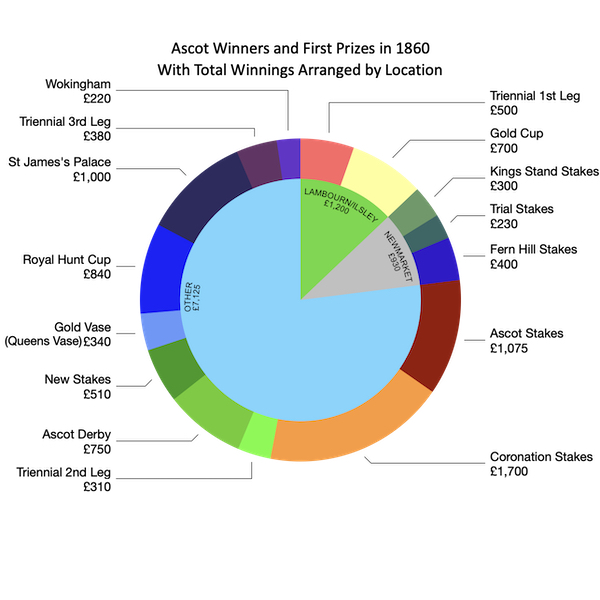

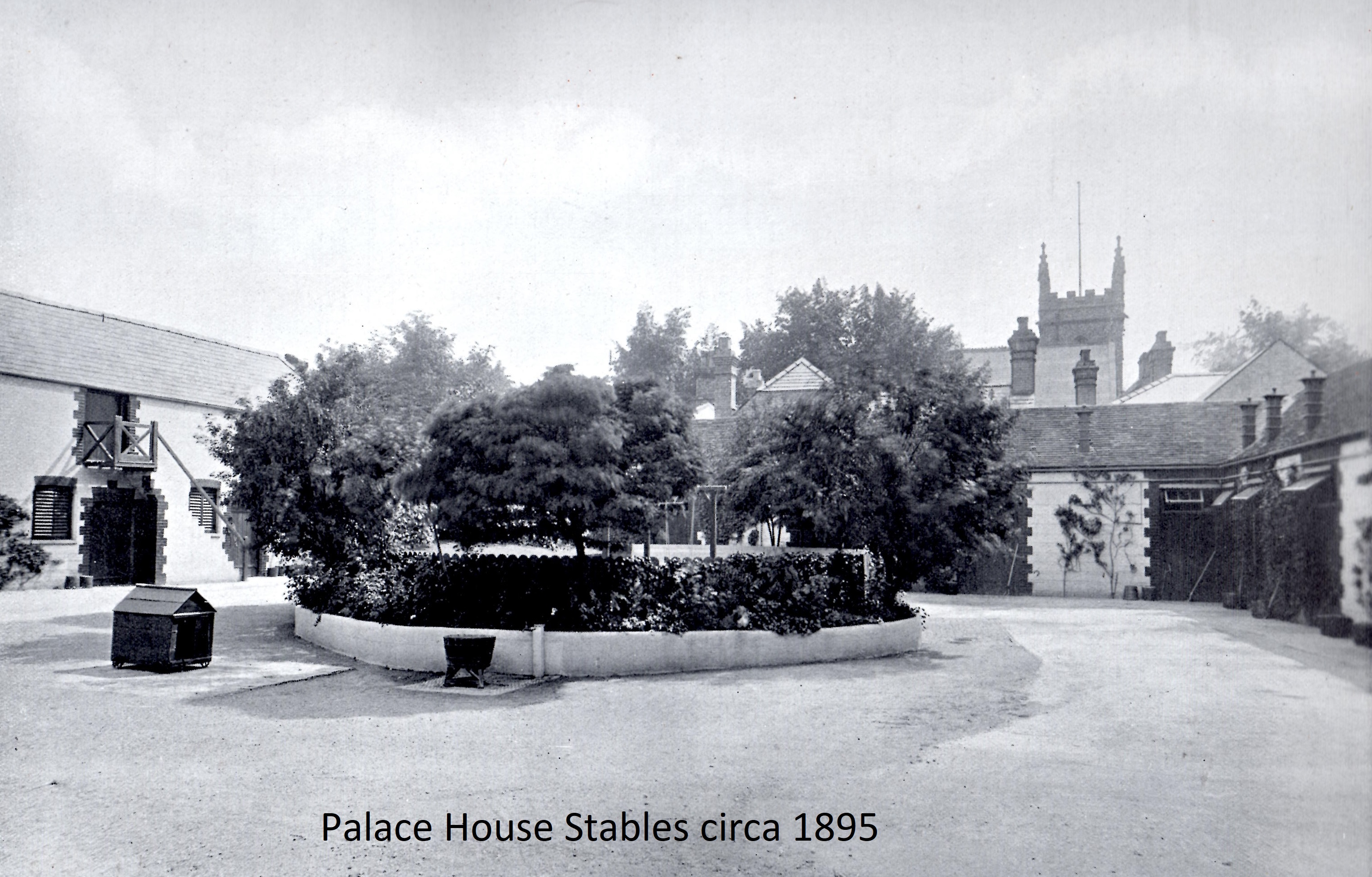
1881-1904 Leopold de Rothschild, Alfred Hayhoe
Alfred Hayhoe took charge of Palace House on the death of his father, gaining an early success in the July Stakes at Newmarket in 1881 with Kermesse. Although he was not as prolific at turning out classic winners as his late father, he did train St Frusquin to land the 1896 2000 Guineas, and towards the end of his time at Palace House he guided Doricles to success in the 1901 St Leger, and St Amant to victory in the 1904 2000 Guineas and Epsom Derby. It was during Alfred's time in charge that the Rothschild Yard and Stables were built between 1896 and 1903.
1881 July Stakes KERMESSE 5/6 fav owned by Lord Rosebery, trained by Alfred Hayhoe and ridden by Cannon
1895 Dewhurst Stakes ST FRUISQUIN 4/7 fav owned by Leopold de Rothschild, trained by Alfred Hayhoe and ridden by Fred Pratt
1896 2000 Guineas ST FRUSQUIN 12/100 fav (SR 1935) owned by Leopold de Rothschild, trained by Alfred Hayhoe and ridden by Tommy Loates

1901 St Leger DORICLES 40/1 (SR 1844) owned by Leopold de Rothschild, trained by Alfred Hayhoe and ridden by Kempton Cannon
1904 2000 Guineas ST AMANT 11/4 (SR 2034) owned by Leopold de Rothschild, trained by Alfred Hayhoe and ridden by Kempton Cannon
1904 Epsom Derby ST AMANT 5/1 (SR 2034) owned by Leopold de Rothschild, trained by Alfred Hayhoe and ridden by Kempton Cannon

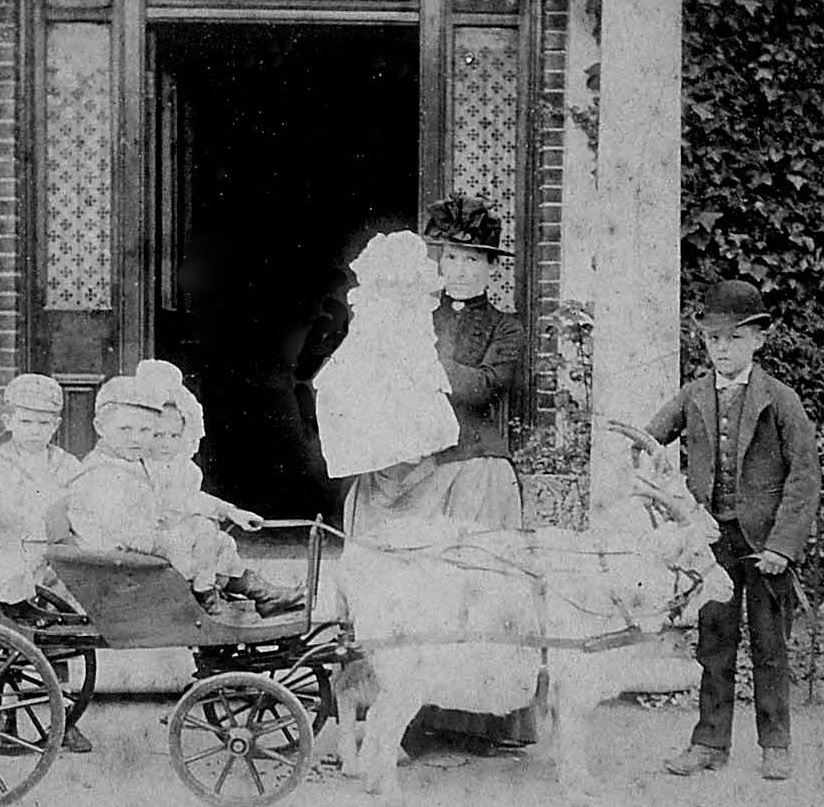
1905-1934 John Watson
In July 1906 the Sporting Life listed all of the Newmarket Stables together with their respective trainers. John Watson was listed at Palace House, having replaced Alfred Hayhoe in 1905. He guided Norman III to 2000 Guineas success in 1908 and Tracery to victory in the 1912 St Leger. In late April 1926 the last Palace House trained English classic winner was Pillion who won the 1000 Guineas when ridden by Dick Perryman. John died in September 1934 and Palace House remained empty until Sir Jack Jarvis made use of it as an overflow yard for the 1935 season.
1908 2000 Guineas NORMAN III (SR 1923) 25/1 owned by August Belmont, trained by John Watson and ridden by Otto Madden
1912 St Leger TRACERY (SR 2095) 8/1 owned by August Belmont, trained by John Watson and ridden by George Bellhouse
1926 1000 Guineas PILLION (SR 1926) 25/1 owned by Anthony de Rothschild, trained by John Watson and ridden by Dick Perryman

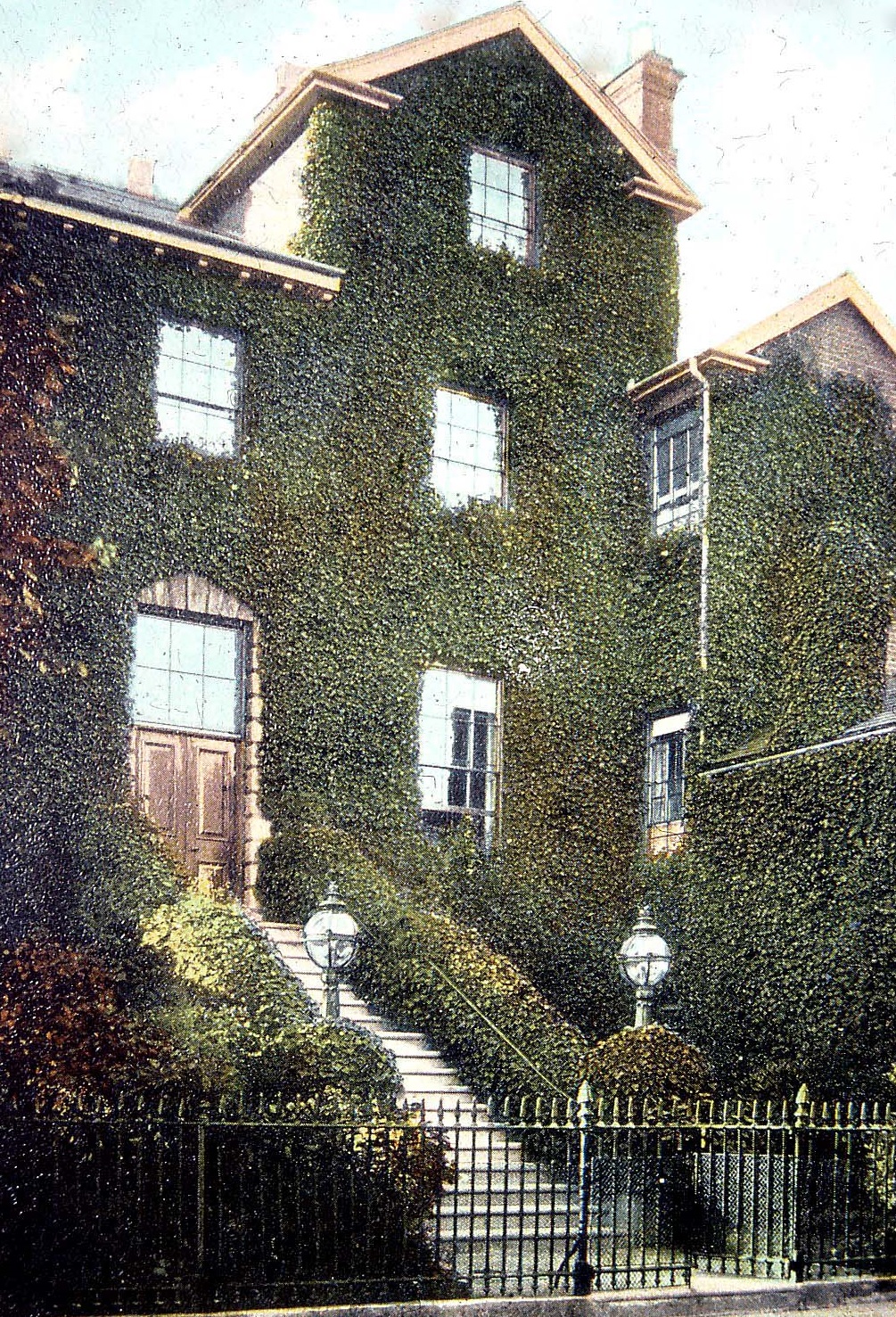
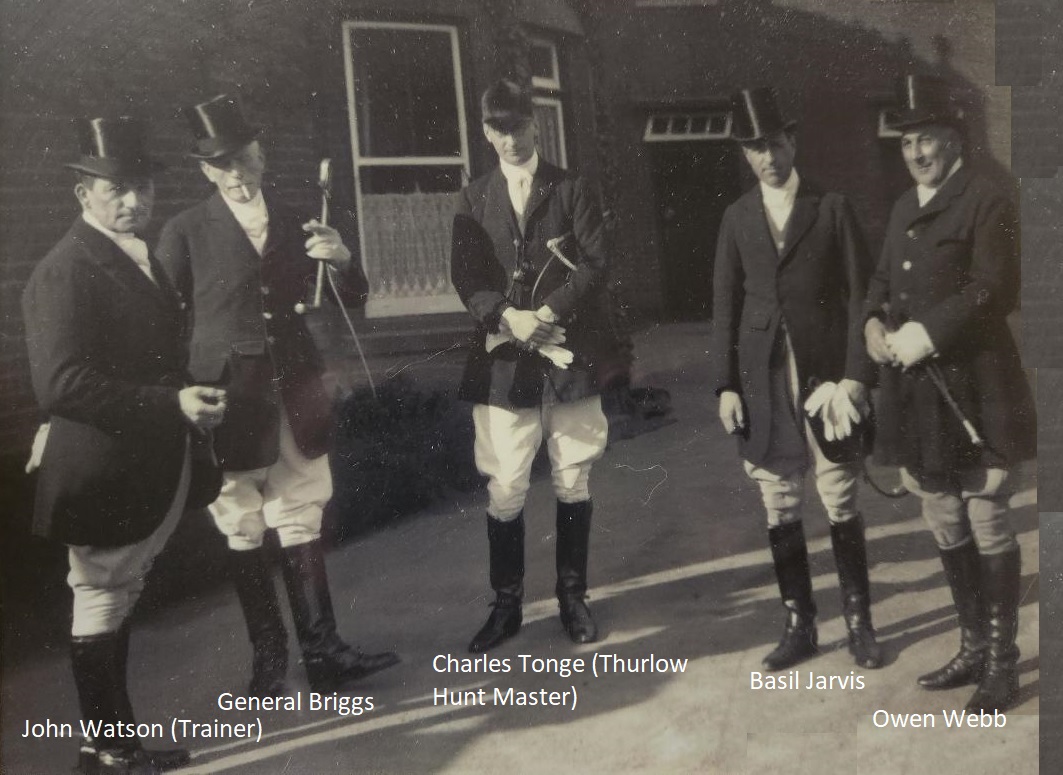

The photo above is of trainer John Watson on a grey horse, but can anyone name the grey horse?
The photo directly above, taken at the Thurlow Hunt, shows trainer John Watson with fellow trainers at Palace House Stables. They are General Briggs, Mr Charles Tonge (Master), Basil Jarvis and Owen Webb.
The photo opposite shows the winning trio of owner Leopold de Rothschild, trainer John Watson and jockey George Bellman after their success with Tracery in the 1912 St Leger
The two photos below show Tracery winning the 1912 St Leger by a comfortable 5 lengths and enjoying its victory in the unsaddling enclosure at Doncaster afterwards.

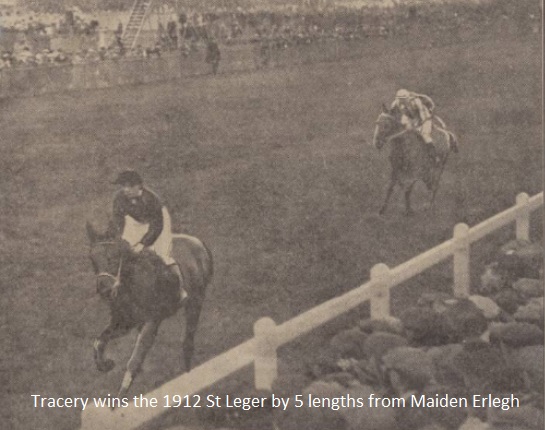
January 1935-46 Sir Jack Jarvis
One of the best known trainers to train at Palace House was Sir Jack Jarvis, with Blue Peter (SR 2089) owned by the 6th Earl of Rosebery and ridden by Eph Smith, winner of the 1939 2000 Guineas and Epsom Derby, his best horse. However, he was denied the Triple Crown because the St Leger was cancelled due to the outbreak of the Second World War. Sir Jack Jarvis, born John Layton Jarvis on 27th December 1887 at Waterwitch House in Newmarket, into a racing family, the third son of William Arthur Jarvis. He became an apprentice at his father's stables in 1902 and rode his first winner when he was just 14 years of age. He was a successful jockey, winning the 1902 Cambridgeshire on Hackler's Pride, followed by the 1905 Ayr Gold Cup on Kilglass. However, his weight denied him the chance of continuing as a Flat jockey and he transferred to National Hunt racing, but retired in his early 20s to work as assistant trainer to his father for the next 5 years. When the First World War broke out in 1914 Jack, aged 27, took over as private trainer to Mr A E Barton at Warren House stables, although the yard had to close in 1916 when Jack served in the Tank Corps. He took charge at Park Lodge after returning from the First World War, continuing to train there until his death in 1967. In January 1935, such was Sir Jack's success, he opened a second training yard at nearby Palace House as an overflow yard, extending his string to 60, having come third in 1934 with 41 winners and £24,268.15s prize money, although in 1947 the stables were leased by Dorothy Paget who installed Harry Jelliss, the son of former Classic winning jockey Henri Jelliss, as her private trainer.
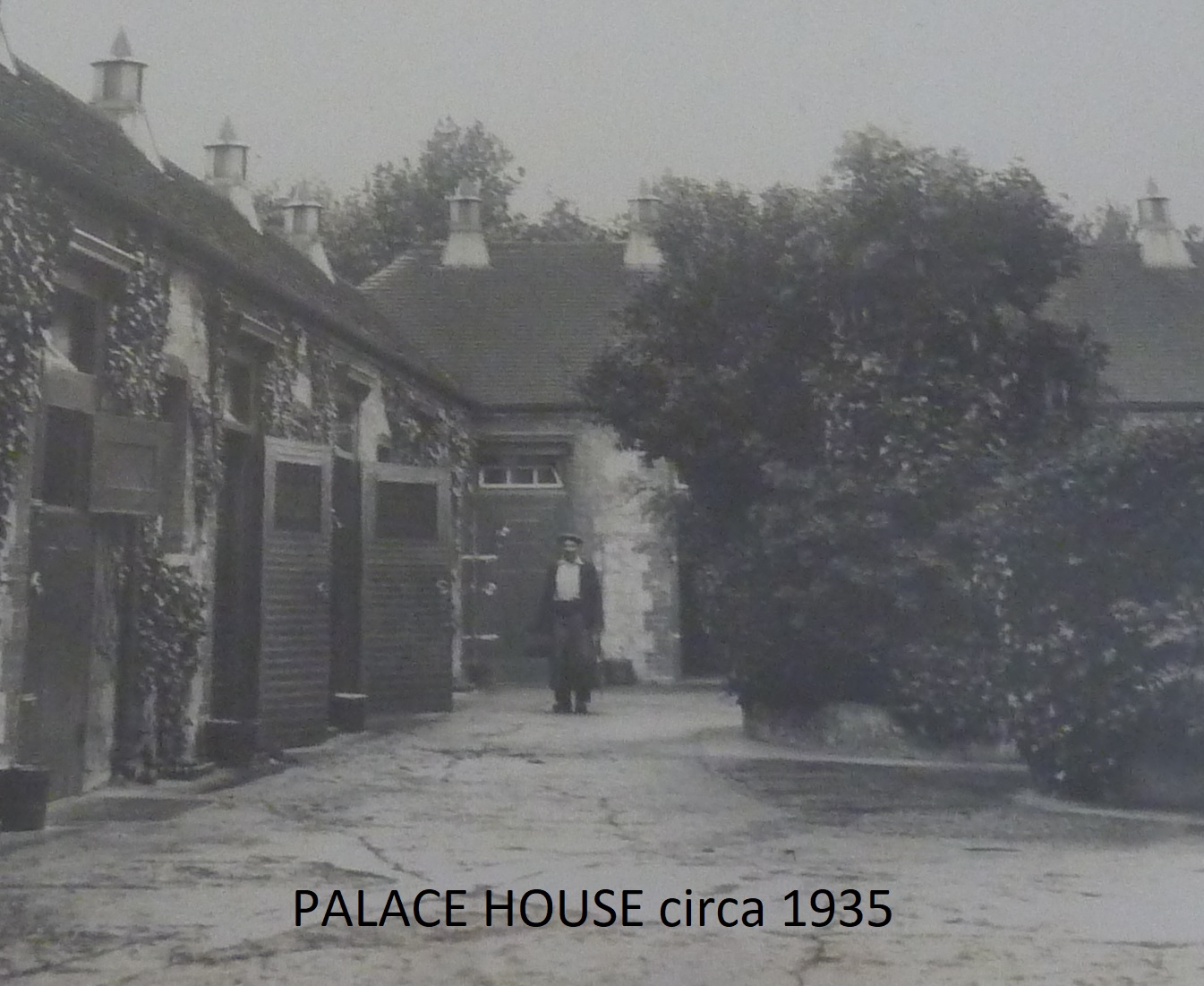

1947-1949 Harry Jelliss, Dorothy Paget
Henri Albert Jelliss, son of 13 times champion jockey of Belgium Charles Jelliss, was born at Mons, Belgium on 23rd November 1891. After schooling he took up an apprenticeship with Tom Jennings junior, opening his winning account aboard Rhyme at Newmarket on 5th May 1908 aged 16 and weighing just 6 stone. He won the 1911 Cambridgeshire with Long Shot for Solly Joel, while later in his career he won 3 English Classics. He retired from riding at the end of a successful 1935 season, launching his training career at Beverley House Stables which were owned by his father-in-law George Blackwell. He gained an early success just 2 days into the Flat season when Paladin won the Chaplin Plate at Lincoln. He won the 1939 Wokingham Stakes at Royal Ascot with America and, in his first full season after the War he won the 1946 2000 Guineas with Happy Knight ridden by Tommy Weston. At the end of that season, while he remained at Beverley House, his son Harry was enticed by Dorothy Paget to train privately for her at Palace House Stables, although he continued to act as assistant to Jack Jarvis at nearby Park Lodge Stables.


1949-1965 Sir Jack Jarvis
Eventually Harry Jelliss severed his association with the difficult Dorothy Paget, and Sir Jack Jarvis took charge again at Palace House Stables as his overflow yard, with Harry appointed as his assistant, although Harry kept his trainer's licence and was able to train a few in his own name. The increased number under Sir Jack's charge enabled him to win back to back British Flat Trainers Championships in 1951 and 1952. His final Classic victory was in 1953 when the filly Happy Laughter (SR 1907), owned by Mr David Wills and ridden by the ill-fated Manny Mercer, won the 1000 Guineas. In 1965, when aged 77, he reduced his training commitments by releasing his lease on Palace House, and two years later Sir Jack died on 18th December 1968.
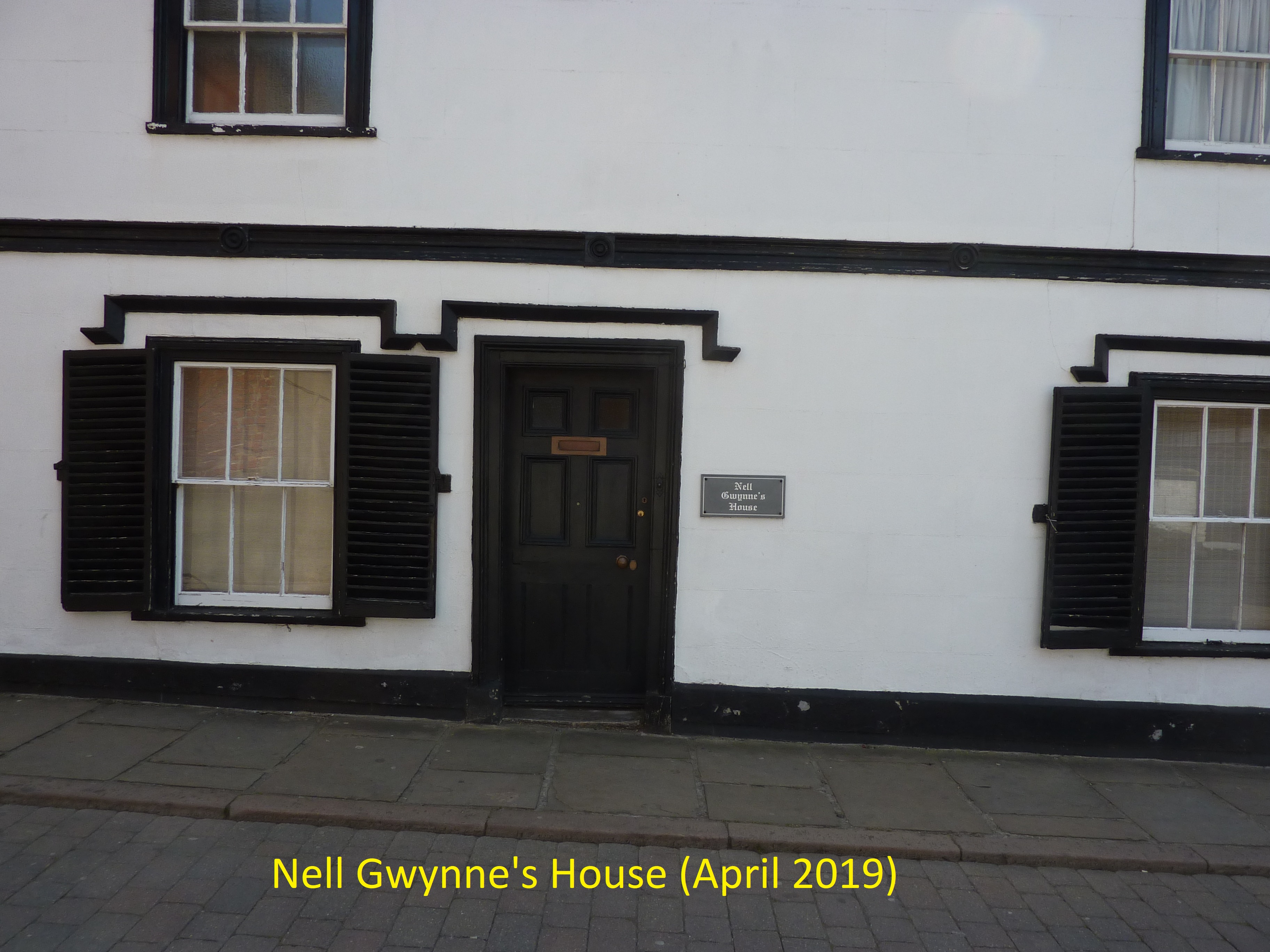
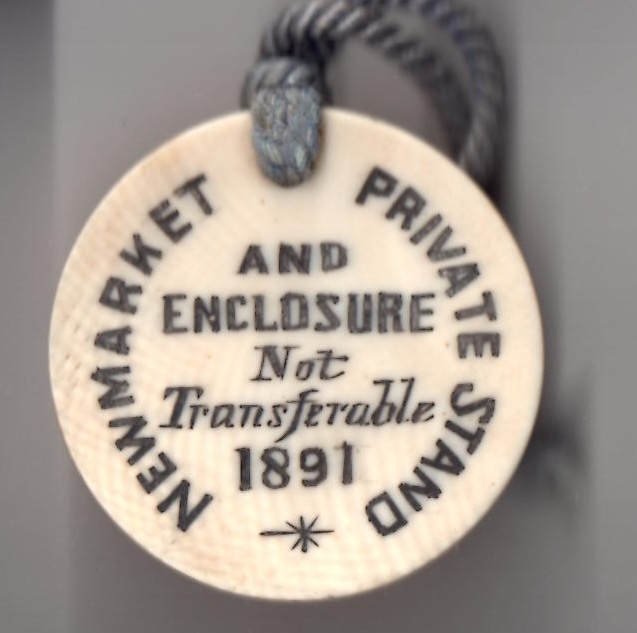
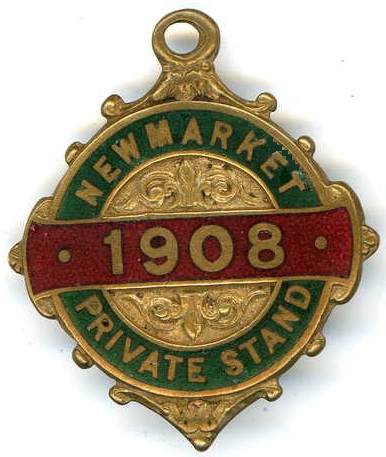

In 1965 Sir Jack Jarvis reduced his training commitments, giving up his lease on Palace House Stables to enable him to concentrate fully on his Park Lodge Stables. Bruce Hobbs leased the yard from Evelyn de Rothschild on a 20-year lease once Sir Jack had left. Bruce Robertson Hobbs was born on Long Island, New York, on 27th December 1920; his father was Reg Hobbs who was Master of the Horse to Ambrose Clark. Bruce experienced success at the racecourse when he was just 12 years old because Clark's horse Kellsboro Jack won the 1933 Grand National. The Hobbs family had moved back to the United Kingdom in 1922 when he was just one year old, his father training at Lambourn. Bruce had his first ride in public at Wolverhampton in March 1936 aged 15, and his career really took off just 2 years later when he became the youngest jockey to ride a Grand National winner, winning the 1938 Grand National aboard Battleship (40/1) trained by father Reg and owned by Mrs M Scott. Bruce continued his successful riding career, winning the Welsh Grand National on Timber Wolf, but tragedy struck later in the season when his horse fell and left him with a broken back; he was hospitalised for 3 months. Clearly his career as a jockey ended, but after the War Hobbs launched his training career, initially as private trainer to the daughter of Solly Joel. He worked as assistant to George Beeby, later joining Captain Cecil Boyd-Rochfort at Freemason Lodge for 8 years, before taking up a similar position with Jack Clayton in Newmarket. Then, at the end of the 1963 season, he was invited to train for David Robinson at Carlburg. In that first, and only season for Robinson, he had a string of 40 horses, 34 of which were two-year-olds. He remained with Robinson for just the 1964 season, moving on in 1965 to Palace House Stables where he gained many notable Group successes, particularly at Newmarket. Although Bruce did not train any English classic winners, he did guide Tyrnavos to victory in the 1980 Irish Derby and trained 48 Group winners in total. Once the lease expired in 1985 Hobbs moved out and was not replaced, making him the final trainer in Palace House's long history. There then followed a long period of decline for the stables, as shown in the photos taken in 1999.
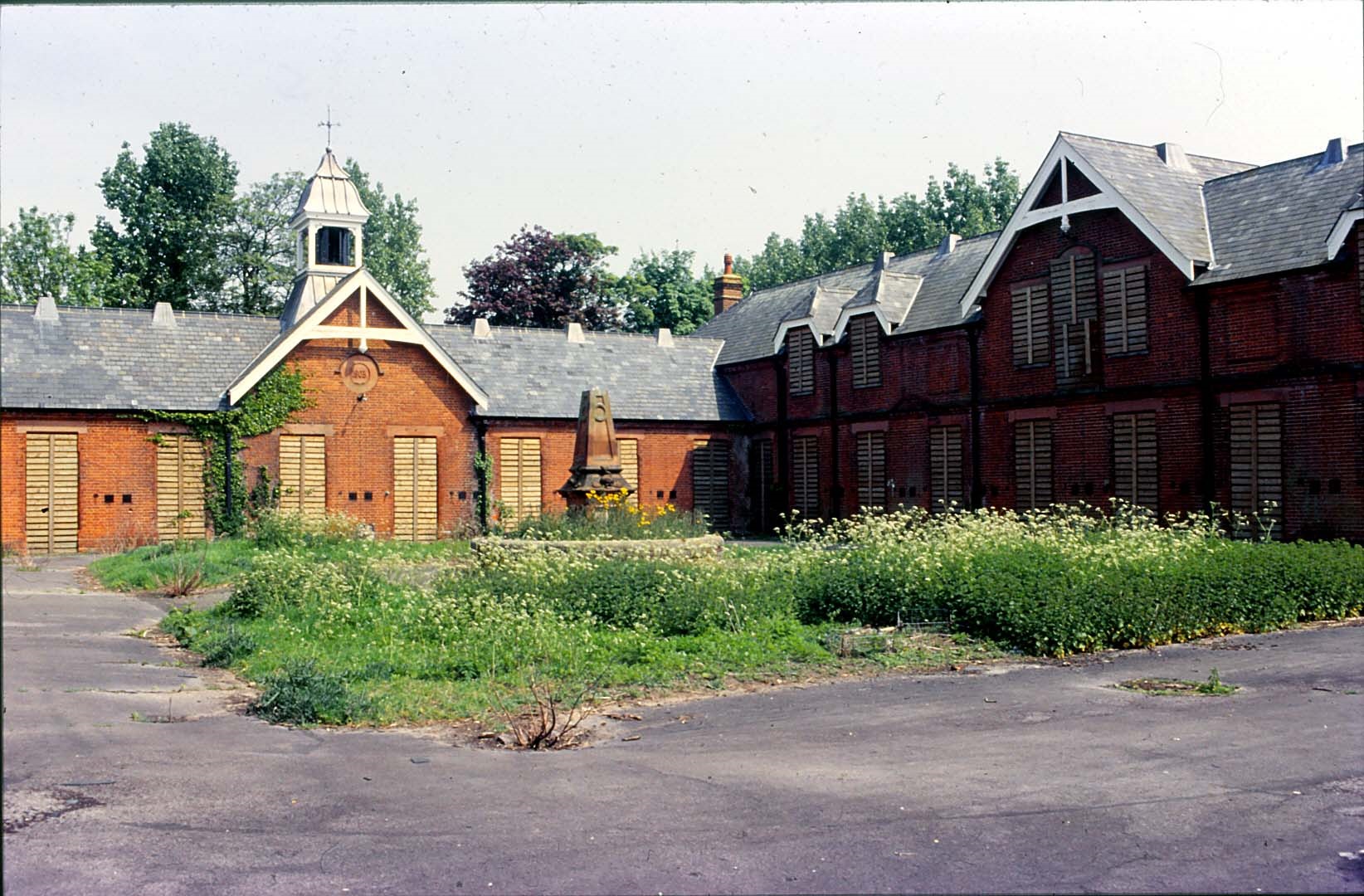
1970 Cherry Hinton Stakes HECLA 13/8 fav trained by Bruce Hobbs and ridden by John Gorton
1971 Bunbury Cup GROTTO 11/1 trained by Bruce Hobbs and ridden by Des Cullen
1972 Sun Chariot Stakes SLEAT owned by David Wills, trained by Bruce Hobbs and ridden by John Gorton
1972 Cheveley Park Stakes JACINTH 9/2 owned by Lady Butt, trained by Bruce Hobbs and ridden by John Gorton
1973 Falmouth Stakes JACINTH owned by Lady Butt, trained by Bruce Hobbs and ridden by John Gorton
1974 Cheveley Park Stakes CRY OF TRUTH 4/1 owned by Miss P Johnston, trained by Bruce Hobbs and ridden by John Gorton
1975 Cherry Hinton Stakes EVERYTHING NICE 33/1 trained by Bruce Hobbs and ridden by Geoff Lewis
1976 Earl of Sefton Stakes CHIL THE KITE 7/2 jt fav trained by Bruce Hobbs and ridden by Geoff Lewis
1976 Middle Park Stakes TACHYPOUS owned by George Cambanis, trained by Bruce Hobbs and ridden by Geoff Lewis
1977 July Stakes ROYAL HARMONY 7/2 trained by Bruce Hobbs and ridden by Geoff Lewis
1979 Somerville Tattersall Stakes STUMPED owned by Tony Villar, trained by Bruce Hobbs and ridden by Geoff Baxter
1980 Craven Stakes TYRNAVOS 5/1 owned by George Cambanis, trained by Bruce Hobbs and ridden by Edward Hide
1980 Falmouth Stakes STUMPED owned by Tony Villar, trained by Bruce Hobbs and ridden by George Duffield
1980 Irish Derby TYRNAVOS (SR 1989) 25/1 owned by George L Cambanis, trained by Bruce Hobbs and ridden by Tony Murray
1982 Fillies Mile ACCLIMATISE 3/1 owned by Jocelyn Hambro, trained by Bruce Hobbs and ridden by Tony Murray

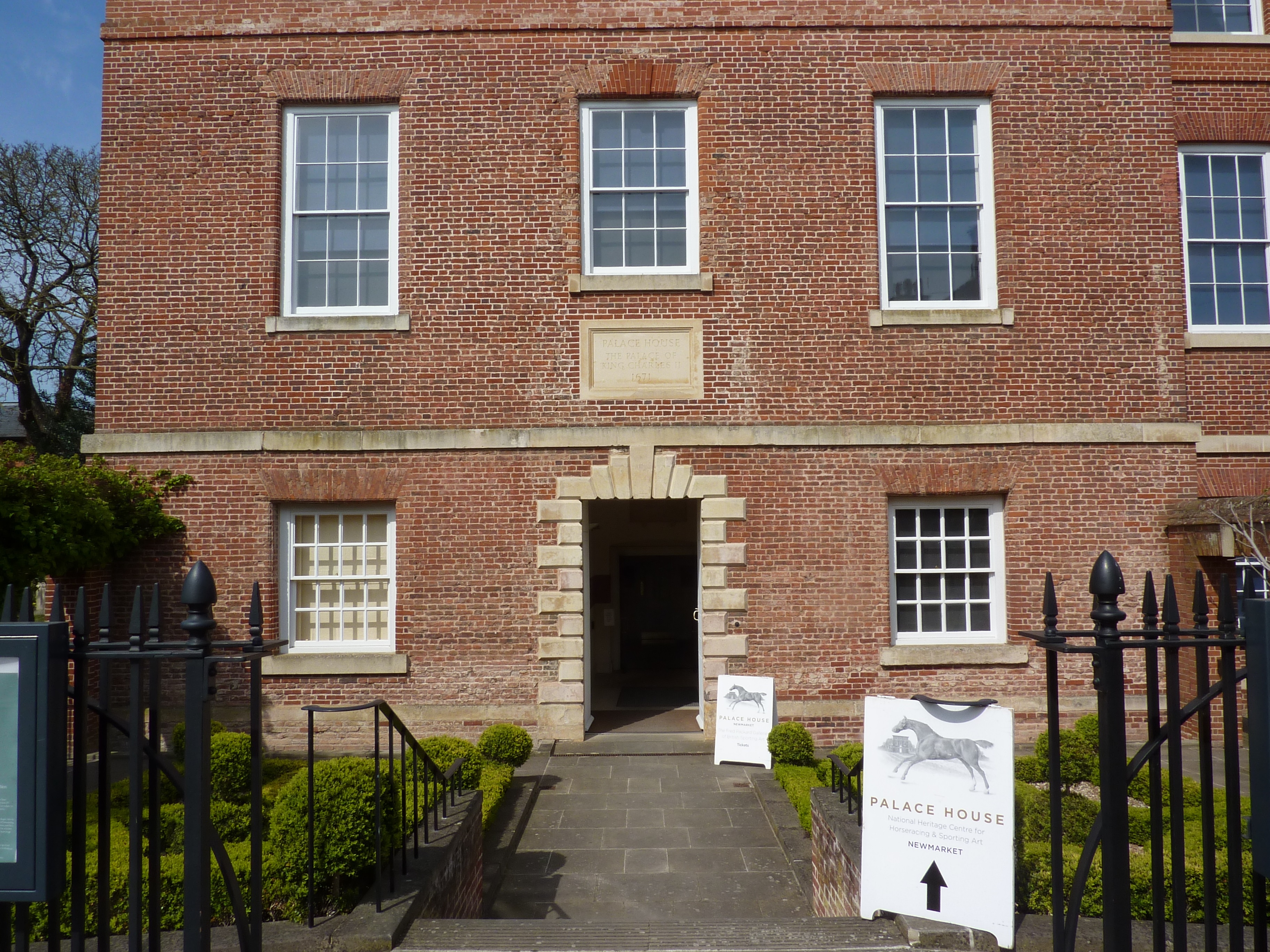
1992-1998 Planning for the future
Although it became clear that Palace House Stables would no longer be used as a training establishment after almost 4 centuries, it took some time to formulate a plan to effectively utilise the historic building. In 1992 a project was launched to restore the House, and it required the support of English Heritage and a significant Heritage Lottery fund grant before work commenced on the project.
2016-present National Heritage Centre for Horseracing and Sporting Art
On 3rd November 2016 HM Queen Elizabeth II formally opened the National Heritage Centre for Horseracing and Sporting Art.
TRACERY (1912 St Leger)
KISBER (1876 Epsom Derby, Grand Prix de Paris)
CEDRIC (1824 Epsom Derby)
ST AMANT (1904 2000 Guineas, Epsom Derby)
COBWEB (1824 Epsom Oaks)



